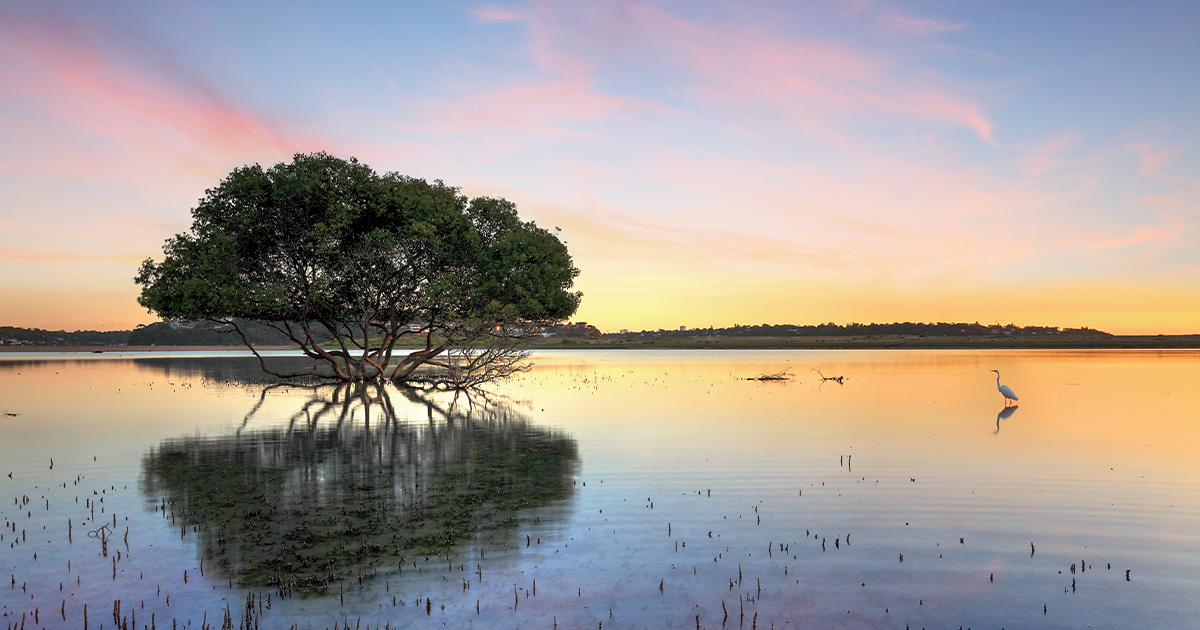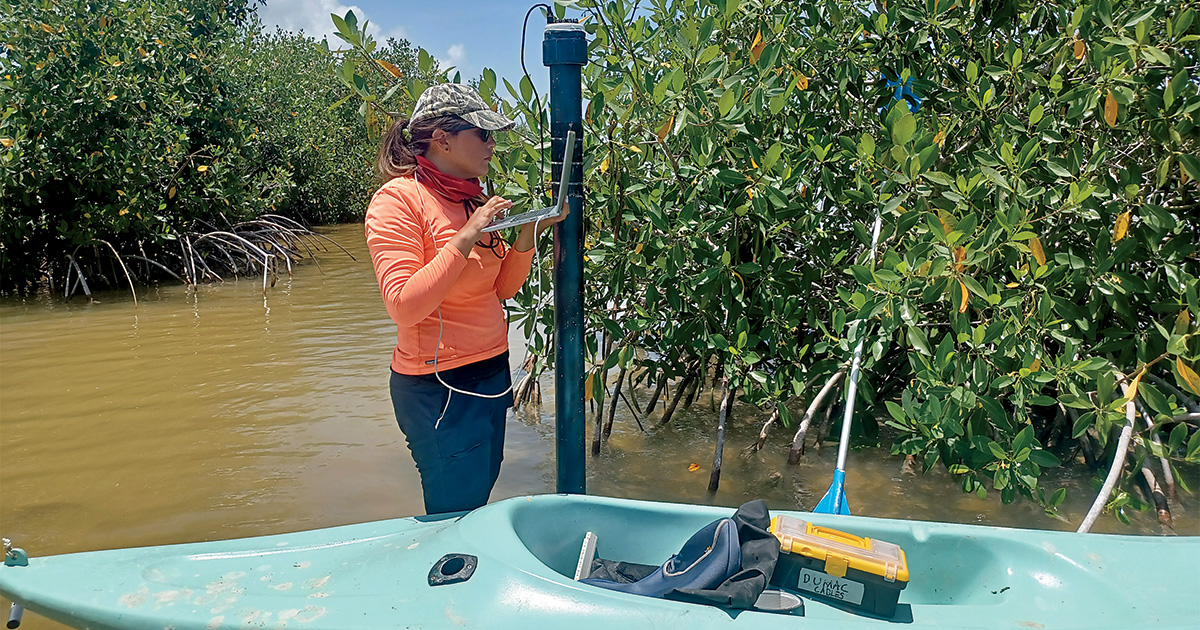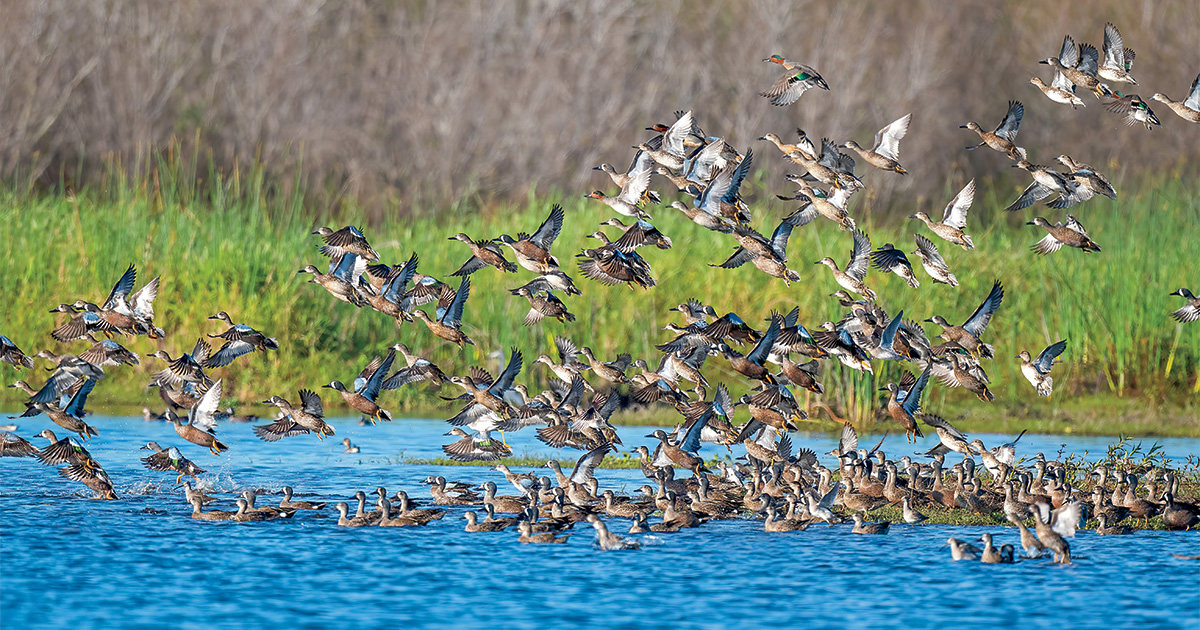A Milestone for Ducks Unlimited de México
Celebrating 50 years of wetlands and waterfowl conservation south of the border
Celebrating 50 years of wetlands and waterfowl conservation south of the border
By Scott C. Yaich, PhD

It had been five years since I first walked along the elevated boardwalk through the restored mangrove swamp in the Ria Celestún Biosphere Reserve. The amount of growth and degree of recovery the habitat had made in that short time was remarkable. Mangrove branches had grown up and over the boardwalk, and I was now walking through a tunnel of green, lush vegetation. There was a unique, pleasant odor with just a hint of the sulfur scent that is characteristic of so many wetlands.
The area’s wildlife had returned in abundance, too. A raccoon scooted across the boardwalk ahead, and a least bittern perched among the vegetation, motionless, only a few feet away. As I came to an opening in the mangroves, I spotted a crested caracara—a raptor—on top of a dead mangrove that was still standing as a sort of monument to the habitat destruction that Ducks Unlimited de México (DUMAC) had reversed. A bare-throated tiger heron clung to a high mangrove branch at the edge of the opening. The grand finale came when I rounded a corner and flushed a large flock of blue-winged teal that headed deeper into the swamp.
It’s always amazing to see how Mother Nature can heal herself when she gets a little help. And providing a little help, in many places and in many ways, is just what DUMAC has been doing for 50 years, as it has led wetlands and waterfowl conservation in Mexico.
In the 1970s, Ducks Unlimited recognized that to achieve its conservation mission for North America’s waterfowl, it would need to expand its reach beyond the breeding grounds of Canada. Research had shown that abundant waterfowl migration and wintering habitat, including wetlands in Mexico, was needed to maximize survival and send the birds back to the breeding grounds in good condition. So in 1974 DUMAC was incorporated to take on the task of conserving Mexico’s most important waterfowl habitats.
Some 20 percent of North America’s waterfowl depend on wetlands in Mexico. An estimated 84 percent of blue-winged teal, the second-most abundant of North America’s ducks, winter in or migrate through Mexico. Approximately 80 percent of the continent’s redheads spend the winter along the Gulf Coast, with the majority gathering on the Laguna Madre of Texas and Mexico. And about 60 percent of all Pacific brant, which breed along the northern fringe of the continent, winter on shallow bays along the Baja Peninsula, where they feed on an abundance of eelgrass.
Mexico’s wetlands also serve as a “continental reserve” for many more waterfowl when wintering habitat in the United States is scarce. During the unprecedented drought of 2022, when only about 50 percent of the wetlands in California’s Central Valley were flooded, large numbers of northern pintails and other duck species continued flying south into Mexico to find wintering habitat.
Over the past half-century, DUMAC has conserved 2.1 million acres of this vital waterfowl habitat, and it has done so with remarkable efficiency. About 95 percent of the organization’s revenue (which is equal to only about 1.5 percent of Ducks Unlimited Inc.’s revenue) is invested in conservation projects. Nevertheless, with a staff of only 31 people, DUMAC conserved 22,170 acres of freshwater wetlands and protected 25,319 acres of seagrass meadows in 2023 alone.
“We pride ourselves in conserving as much as we can with the resources we have available,” says Eduardo Carrera, DUMAC’s longtime CEO and executive director. “We focus on working in the most important areas and using conservation approaches that have the greatest and longest-lasting impact on waterfowl and other natural resources.”

DUMAC is a leader in wetlands and waterfowl research and conservation education in Mexico.
Mangrove swamps are salt-tolerant tropical forests that occur in the transition zone between land and sea. These unique coastal wetlands are among the world’s most productive and valuable ecosystems. In addition to providing habitat for ducks and an array of other wildlife, mangrove swamps harbor many commercially valuable fish and crustacean species such as snapper, snook, and blue crabs. Mangroves also protect communities by serving as a natural buffer from storm surges. The total value of the ecosystem services provided by these wetlands was recently estimated to be $42,000 per acre, and Mexico’s nearly 2 million acres of mangroves contribute $70 billion annually to the national economy.
Mangroves have been identified as exceptionally efficient storehouses of “blue carbon,” a term used to describe carbon stored in coastal ecosystems and the ocean. In fact, mangrove swamps can store more than 440 tons of carbon per acre and hold it for more than 5,000 years. This makes mangroves far superior to other forest types for carbon sequestration.
Unfortunately, mangrove swamps are among the most threatened ecosystems in the world. More than 25 percent of Earth’s mangroves have already been lost, and many of those that remain are threatened by the rapid expansion of agriculture, aquaculture, and coastal development. “Mangrove restoration has long been a conservation priority for DUMAC because of their importance to waterfowl,” says John A. Tomke, DUMAC’s chairman of the board. “But with the emerging information about their ability to store carbon and provide other ecosystem services, mangroves are rising to the top of our priority list.”
In fact, DUMAC has led the way in developing the most effective and cost-efficient methods of restoring mangroves. When replanting efforts by others failed, DUMAC demonstrated that hydrologic restoration was the key to success. To date, the organization has conserved almost 50,000 acres of mangrove swamps. DUMAC received a national award from CONAFOR, Mexico’s equivalent of the US Forest Service, in recognition of its leadership in mangrove conservation.
Among DUMAC’s most important projects is an effort to conserve 250,000 acres of mangroves on the internationally designated Ria Celestún Biosphere Reserve on the Yucatán Peninsula. This vast coastal wetland complex supports 304 species of migratory and resident birds, including thousands of waterfowl and a spectacular local population of flamingos. The dense mangrove swamps also sequester more than 9 million tons of carbon, according to recent estimates.
Sadly, parts of the Celestún reserve have been degraded by the construction of a roadway, which has significantly altered natural tidal flows into the estuary. To help restore the natural tidal influence, DUMAC has developed a plan to dredge accumulated sediment and re-engineer the road. DUMAC is leading the partnership to implement this project and has already secured commitments of $3.7 million for this vital restoration work.
Another threat to the mangroves is coastal erosion caused by a large pier built on the Yucatán’s north coast. The erosion threatens to create a pass that would permit large volumes of water from the Gulf of Mexico to flow into the estuary, dramatically altering the salinity and hydrology. DUMAC is currently conducting research examining the erosion problem in an effort to identify possible solutions.
To build support among local communities, DUMAC takes a holistic approach to much of its conservation delivery. A prime example is DUMAC’s work at Lake Cuitzeo, Mexico’s second-largest lake. The fundamental problem plaguing the lake is degraded water quality. Historic land-use practices have caused excessive amounts of sediments and nutrients to flow into the lake, fueling the rapid growth of cattails, which have choked large areas once used by waterfowl and other wildlife.
DUMAC is tackling Lake Cuitzeo’s challenges using both traditional and nontraditional methods. Traditional approaches include aquatic vegetation control and the installation of water-control structures and sediment traps. However, many of the excess nutrients flowing into the lake stem from substandard management of human and agricultural waste. After careful study, DUMAC determined that the most effective way to deal with the water pollution problem was by going to the source. Working with local communities, DUMAC has helped residents install dry toilets and build small wastewater treatment systems to reduce the flow of organic materials and nutrients into the watershed. In 2023, these efforts benefited almost 5,600 people while improving water quality and wetland habitat in the lake.
DUMAC also holds workshops to encourage farmers and ranchers to adopt improved nutrient-management practices. As a result, DUMAC receives community buy-in for wetlands conservation by improving the everyday lives of people living in the watersheds of Mexico’s most important wetlands. DUMAC is now expanding this approach in other key areas to secure the durable conservation results that community involvement delivers.
To amplify its conservation impact, DUMAC sponsors a variety of professional development programs, environmental education, and scientific research. Through its internationally recognized RESERVA program, which is celebrating its 35th anniversary this year, DUMAC has provided advanced training to more than 682 conservation professionals from Mexico and 23 other Latin American and Caribbean countries. All RESERVA participants have management responsibility for conservation areas and are able to immediately put their training to work.
DUMAC’s wetland and waterfowl workshops, mangrove workshops, farmer and rancher workshops, and other training opportunities all extend the geographic reach of its conservation leadership. Now DUMAC’s Teaching the Teachers program is extending its reach across generations. This accredited program provides environmental education to teachers in schools throughout high-priority watersheds. Participating teachers then partner with DUMAC to develop and promote an environmental ethic among their students, which will carry forward to future generations.
Like its affiliates in the United States and Canada, DUMAC uses the best available science to guide its conservation efforts and actively participates in a variety of research studies. DUMAC compiled and made available for public use the first national wetlands inventory of Mexico and is now in the process of updating this key scientific database. DUMAC is also currently leading an effort to map and monitor seagrass meadows in the Laguna Madre, which is the main food source for redheads in this crucial waterfowl wintering area. And along Mexico’s Pacific Coast, DUMAC scientists have documented the rapid and ongoing loss of mangrove swamps caused by unsustainable shrimp farming practices. Using satellite imagery and maps, these scientists were able to show policy makers that the explosive growth of shrimp farms in Sinaloa and Sonora has resulted in the loss of almost 74,000 acres of mangroves in just a few years. This data is now being used to develop more sustainable shrimp farming practices that will help conserve the mangroves.
Even with its significant record of conservation achievement and leadership in Mexico, DUMAC is still too often characterized as what DUMAC President Bill Ansell calls “Ducks Unlimited’s best-kept secret.” Ansell says, “We are working hard to make DU members and others more aware of DUMAC and the key role it plays in continental waterfowl and wetlands conservation. We have made progress, but we will be doing much more to grow the organization. We are confident that as the breadth of the natural resource and human benefits of DUMAC’s work becomes more widely known, we will increase the financial support that will enable us to grow our capacity to conserve the mangroves and other important waterfowl habitats of Mexico.”
Dr. Scott Yaich enjoyed a 36-year career in wetlands and waterfowl conservation. He retired as DU’s chief scientist in 2017 and now volunteers as a member of the DUMAC board of directors.

Dr. Edward D. and Sally M. Futch Charitable Foundation
Dr. Edward Futch was a caring Texas physician, adoring husband, sportsman, conservationist, and philanthropist. Ed married the love of his life, Sally Trueheart McCullough, in 1944 and spent the next 66 years with her. The pair shared an acute interest in the people, places, and habitats of the Texas Gulf Coast, supporting dozens of projects, studies, and policies beneficial to waterfowl and people over the years.
Understanding that waterfowl know no borders and that research and education are key for appropriately stewarding the natural environment, the Futch Foundation began annually supporting DUMAC’s research and education programs in 2014. With more than $2 million in support to DUMAC over the last 10 years, the Futch Foundation carries on Ed and Sally’s legacy of expanding conservation and supporting wetlands and waterfowl along the Gulf Coast.
Ducks Unlimited uses cookies to enhance your browsing experience, optimize site functionality, analyze traffic, and deliver personalized advertising through third parties. By continuing to use this site, you agree to our use of cookies. View Privacy Policy